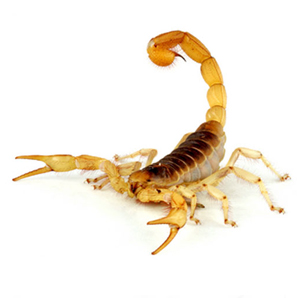Scorpions are predatory arachnids of the order Scorpiones. They have eight legs and are easily recognized by the pair of grasping pedipalps and the narrow, segmented tail, often carried in a characteristic forward curve over the back, ending with a venomous sting. Scorpions range in size from 9–12 mm (0.35–0.47 in) in Microtityus minimus to 23 cm (9.1 in) in Heterometrus swammerdami.
The evolutionary history of scorpions goes back to the Silurian period 435 million years ago. They have adapted to a wide range of environmental conditions, and they can now be found on all continents except Antarctica. There are about 1,750 described species, with 13 extant (living) families recognised to date. Their taxonomy is being revised in the light of genomic studies.
The vast majority do not represent a serious threat to humans, and healthy adults usually do not need medical treatment after being stung. Only about 25 species have venom capable of killing a human. In some parts of the world with highly venomous species, human fatalities regularly occur, primarily in areas with limited access to medical treatment.
Scorpions with their powerful sting appear in art, folklore, mythology and numerous brands. Scorpion motifs are woven into kilim carpets for protection. Scorpio is the name of a constellation and the corresponding astrological sign; a classical myth tells how the giant scorpion and its enemy, Orion, became constellations on opposite sides of the sky. The name has been used for a Roman siege engine, several warships, a type of tank, and a yoga pose with the legs pointing forwards over the head, like the animal's tail.

EMPEROR SCORPION
The Emperor scorpion is one of the biggest scorpions in the entire world. These adults sometimes average 20 centimeters (7.9 inches) in length and weighing in at over 30 grams. One of the only scorpions that come in close to size is the forest scorpion. Read More About the Emperor Scorpion.
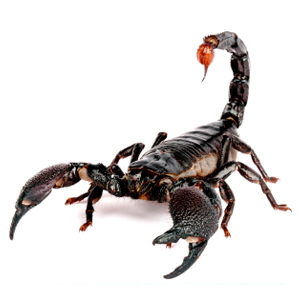
RED CLAW SCORPION
Red Claw Scorpions can sometimes be used as pets but people who have never owned them before should take this as a warning. Red claw scorpions are easily made aggressive and are not recommended for people who are beginer scorpion owners Their sting is reported to be the same intensity of a bee sting. Read More about the Red Claw Scorpion.
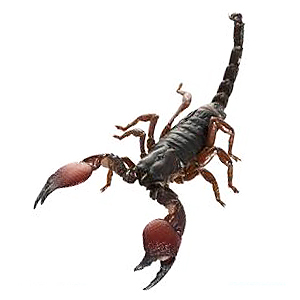
RED SCORPION
The Indian Red Scorpion is possible one of the most dangerous scorpions known to the public. It’s common to Pakistan, India and Nepal. This scorpion got its name because of its often orange/red body color. These scorpion are nocturnal arachnids usually praying on spiders, bugs and other types of insects. Read More about the Red Scorpion.
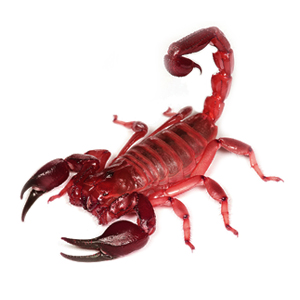
BLUE SCORPION
The Blue scorpion is also known as the “Alacran Azul” or “Blue Scorpion” when translated to the English language. It is also known as the slender brown scorpion, bark scorpion and brown bark scorpion. They are found in the US, Mexico, South America, Columbia, Ecuador, Cameroon, Gabon and Venezuela. Read More about the Blue Scorpion.
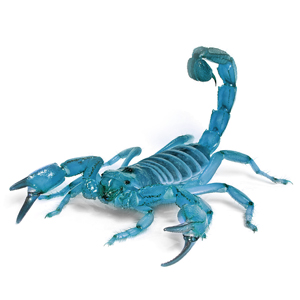
ARIZONA BARK SCORPION
The Arizona bark scorpion is a small light colored brown scorpion that is common the southwest U.S. and the Sonoran Desert. Adult Male bark scorpions can reach up to 8 centimeters long (3.14 inches), however, a female is smaller with a length of 7 centimeters or (2.75 inches). Read more about the Arizona Bark Scorpion.
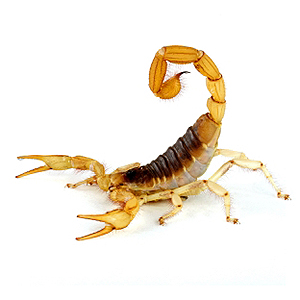
PSEUDO SCORPION
The Pseudo scorpion is usually 3-4mm long and has a rich mahogany color and has four pairs of legs that increase sequentially in length. It has eyes of both sides of its cephalothoraxes and has a 12-segment abdomen. The body kind of resembles a tear drop. The pedipalps, near the first pair of legs are about twice as long as the back of its legs. When extended they measure about 7-9mm. Read More about the Pseudoscorpion.
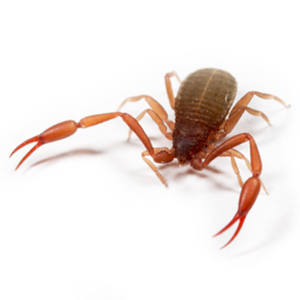
GIANT FOREST SCORPION
The forest scorpion usually resides in Malaysia and India. Its usually large, stocky and heavy. The color is black and they may grow up to 5 inches in length. They usually live under logs and rocks but occasionally tend to burrow themselves in the ground. The look pretty close to the emperor scorpion and are sometimes mistaken and sold as emperor scorpions in pet stores. The forest scorpion is much more aggressive than the emperor so be careful if you buy scorpions. Read More about the Forest Scorpion.
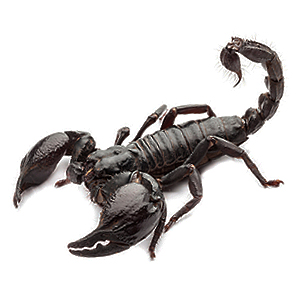
TAILLESS WHIP SCORPION
Tailless Whip Scorpion: The tailless whip scorpion, often called whip spiders) are referred to as amblypigids. They have been given there name because of there lack of a tail. Spiders, mites, daddy longlegs and other less known groups are their closes relative. Click here to see a diagram of the tailless whip spiders closes relatives. Read More about the Tailless Whip Scorpion.
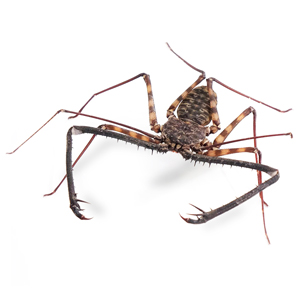
FAT TAIL SCORPION
Fat Tail Scorpion: The fat tail scorpion are small with a full grown adult size of 4in. The females are typically larger than the males and the tail on this scorpion is very thick and fat. That’s where the name comes from. This scorpion also has very strong venom and they don’t look like other species do. There color is kind of transparent and you could see through them. Read More about the Fat Tail Scorpion.
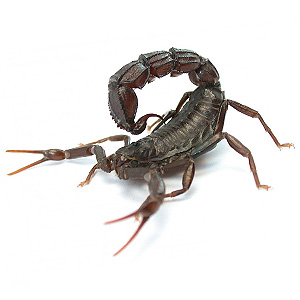
DEATH STALKER SCORPION
Death Stalker Scorpion: The death stalker scorpion earned its name or a reason. Its venom is extremely deadly and any ever been stung by one would of been lucky to get out alive. Although, this venom has actually been known for medical purposes. Its venom has positive uses for medical care. Studies are being done to find out its effectiveness and the long terms effect that could occur from using it. Read More about the Death Stalker Scorpion.
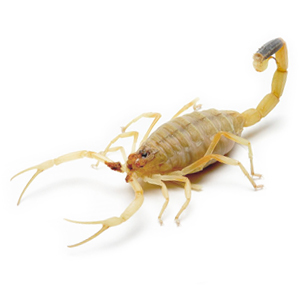
THREE STRIPED SCORPION
The three striped scorpion or the striped bark scorpion is a common scorpion found in the middle of the United States. A medium length scorpion is usually longer than 70 millimeters (around 2.75 inches), it is pale-yellow in color and can be identified by two or three dark, longitude stripes on it carapace, with a darker triangle above the ocular tubercle. Read More about the Three Striped/Striped Bark Scorpion.
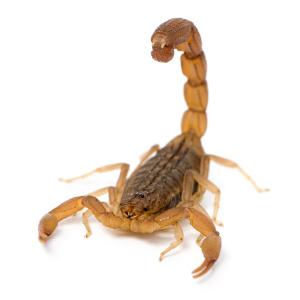
ARIZONA HAIRY SCORPION
The giant Arizona hairy scorpion is the one of the largest scorpions in Arizona, reaching about 6 inches in length. Their bodies are usually colored brown with lighter yellow pinchers and legs. There name comes from the brown hairs that are all over their bodies. Those hairs are used to detect air and ground vibrations. They have a long tail tipped with a bulb of poison and stinger with great big pinchers and 4 pairs of legs. Read More about the Arizona Hairy Scorpion.
